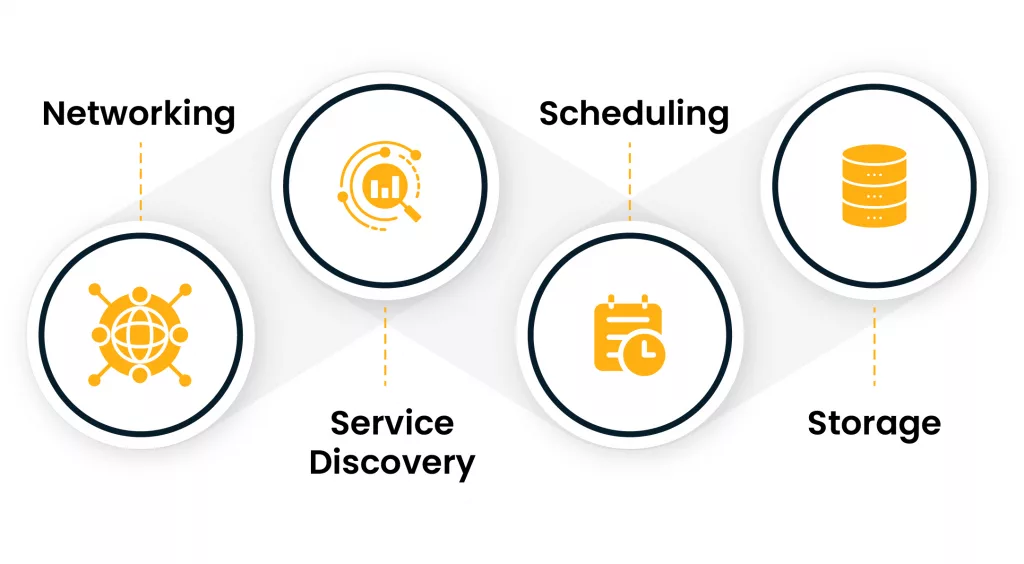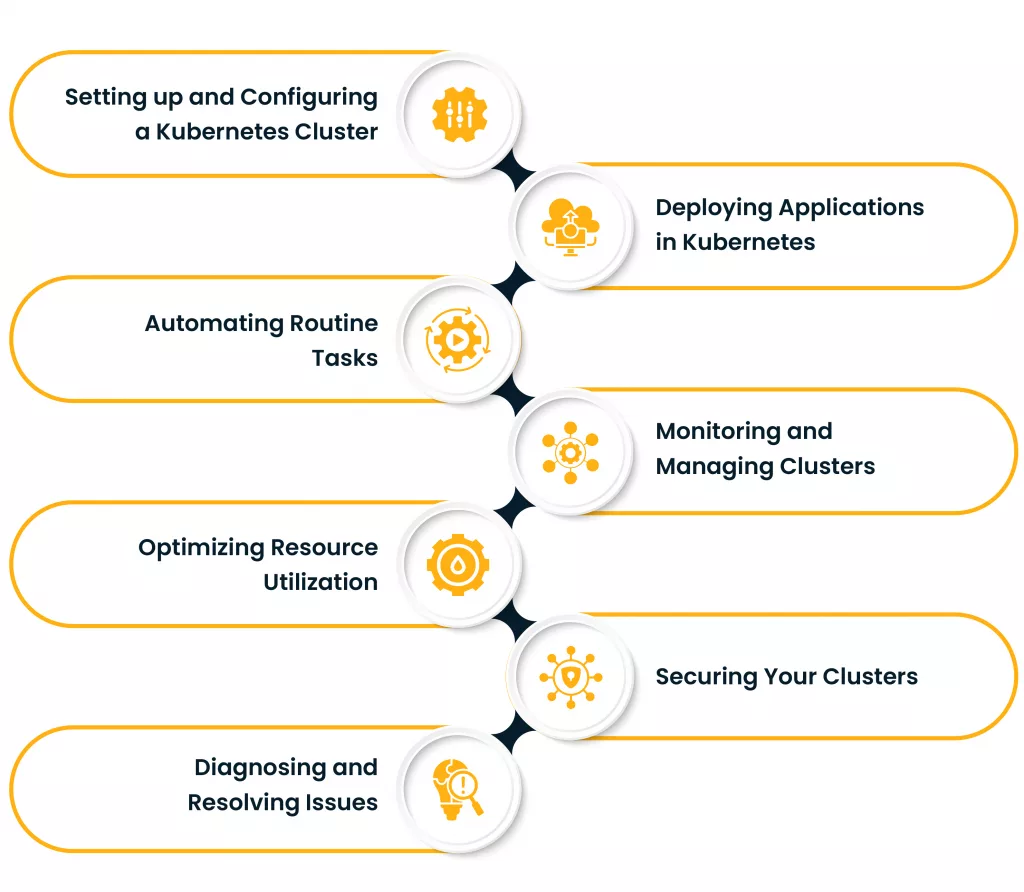In the rapidly evolving tech industry, it’s crucial to remain current with the latest trends. Companies aim to provide improved, quicker, and more dependable services to their customers. Thus, combining microservices and Kubernetes has a significant impact.
We have previously covered the fundamentals of microservices architecture in our past blog. In this post, we will deeply explore Kubernetes, clarifying the concepts, examining the advantages, and helping you determine if your business truly requires Kubernetes. Whether you’re an entrepreneur looking to enhance your operations or a developer seeking to expand your knowledge, this insight will give you the information needed to make a well-informed choice.
We will make complicated ideas easier to understand and address common concerns that might be stopping your business from adopting this innovative technology. We will discuss everything from the fundamentals to the advanced, guaranteeing you develop a complete comprehension by the conclusion.
As your organization becomes more digital, it must be more agile. Microservices are a perfect match for the born-in-the-cloud world we now live in. In this era of digital transformation, businesses need the ability to continuously grow. To survive, organizations must become more dynamic. Enter Kubernetes. It’s an even more powerful force for change. Large organizations want to adopt it, but small businesses don’t want to be left behind. So how does Kubernetes benefit all comers? The digital journey of your company starts now.
What is Kubernetes (K8s)?
Kubernetes is a free and open source that offers a helping hand in managing containers for you. It helps in getting an app up and growing and fixes the app when it breaks. Containers allow apps to be run by combining all the necessary pieces together and making sure they work fine no matter where you are at any point in time. We have discussed more about containers and creating the container image in another blog.
Picture a big application with lots of different services, each running in its own container. Trying to handle all these containers by hand can quickly get pretty messy, especially when you want to scale your app, keep it running all the time, or update components. That’s where Kubernetes jumps in and makes your life easier.
Functions of Kubernetes
Kubernetes offers a comprehensive range of tools and features that enable you to:

- Deploy Containers: Kubernetes conceals the underlying infrastructure and offers an efficient way of deploying your applications in containers. By using configuration files, you can specify your application’s desired state, and Kubernetes guarantees that the current state aligns with the intended state.
- Scale Applications: As your app gets more popular, Kubernetes can automatically adjust how many containers you have by itself, depending on set rules. Your app can handle changing amounts of traffic without you having to do anything.
- Load Balancing: Kubernetes spreads out the traffic coming in between different app versions to make sure resources are used wisely and no one app gets too much work.
- Self-Healing: If a container or node has problems, Kubernetes identifies and fixes them quickly by replacing the container or adjusting the resources to keep your application running smoothly.
- Rolling Updates and Rollbacks: Kubernetes supports a convenient update of your services by allowing automatic updates and patches. It replaces old containers with new ones and in case anything goes wrong, you can easily reverse back.
- Storage Orchestration: Kubernetes lets you set up and manage application settings on your own, without worrying about the actual code. This makes it simpler to keep everything up to date.
- Configuration Management: Kubernetes simplifies the process of keeping application configurations up to date by enabling separate setup and management from the application code.
- Resource Utilization: Kubernetes enhances CPU and memory resource allocation for containers, ensuring efficient utilization and peak performance of your application.
Kubernetes will comprise several machines will one of them being the master of the cluster and the other ones, the nodes, will handle the running of application containers. Following that specification, users build their apps, and they describe in configuration files what they want it to be and Kubernetes makes sure that the current state is the same as the desired state.
In other words, Kubernetes helps companies automate the orchestration of deploying applications at scale – and scale is what matters in today’s software world, with the rise of microservices architecture and cloud technologies, among others.
Popularity of Kubernetes
Figure 2 presents numbers related to Kubernetes that indicate the rising popularity and use and the reasons for this.

Why Should a Business Adopt Kubernetes?
Choosing Kubernetes can be advantageous for companies, particularly those managing intricate and quickly changing applications. Figure 3 illustrates several convincing factors for why businesses should think about implementing Kubernetes:

- Scalability: By leveraging Kubernetes organizations, it is possible to adapt their apps based on the demanded needs easily; with no need for your involvement the app will work under any given traffic load conditions meaning great performance and user satisfaction.
- High Availability: Kubernetes is designed to keep your workloads running as planned; it automatically shifts tasks around to avoid downtime or failures. When one crashes or fails due to some internal issue with it such as bad configuration files then one can start another instance without stopping existing ones thereby maintaining availability for clients during maintenance period.
- Resource Efficiency: When running Kubernates, it ensures optimally distributed resources (such as computer power and memory) between the different containers to prevent wastage as well as smoothening operations; thus, preventing spending excess money while making the entire system run better.
- Automated Updates and Rollbacks: Kubernetes permits smooth updates by gradually substituting old containers with new ones. This solution minimizes the period of time when the system is not working and competes with the problems connected with the articles. If the issue arises, rolling back can be managed quickly.
- DevOps and CI/CD: Kubernetes goes great with DevOps and Continuous Integration/Continuous Deployment (CI/CD) workflows. It makes testing, putting things out there, and keeping an eye on them automatic, making the whole process of making software a lot smoother.
- Microservices Architecture: Kubernetes nicely integrates with microservices making it simpler for enterprises to disaggregate their software into smaller and more manageable services which can boost velocity through enhancing scalability and adaptability in software engineering.
- Multi-Cloud and Hybrid Cloud Support: The capability to move applications to other cloud providers and on-premises infrastructure is a feature of Kubernetes. As a result, such adaptability ensures that customers are restricted in their option to use a specific vendor and therefore have the freedom to use the best environment for the workload.
- Resource Isolation: The containers on Kubernetes are isolated from each other and this prevents the problem which emerges inside of one container from transmitting to others. This also results in a much better level of security and reliability in the multi-tenant environment.
- Resource Utilization and Cost Management: Kubernetes makes it simpler to supply the required resources and control the costs, avoiding overprovisioning or underprovisioning and preventing waste of resources. This assists businesses in optimizing returns on investments made in their systems.
- Community and Ecosystem: Kubernetes has a flourishing open-source community and a range of tools, extensions, and support available, providing businesses with a wealth of knowledge, assistance, and integration opportunities.
- Futureproofing: As cloud-native technologies become more popular, having expertise in Kubernetes can help organizations prepare for growth and the development of new ideas.
- Complexity Management: With Kubernetes, developers can easily set up and manage applications running on containers without bothering themselves about technicalities; it enables them to concentrate on feature innovation rather than handling such complex tasks.
- Rapid Deployment: In current market conditions where companies have to adapt to changing demands rapidly, it is very essential for them to quickly add extra functionalities and services.
Kubernetes gives your business everything it needs to make things run smoother, improve how your apps work, and keep up with the tech world. It helps companies use the latest ways of making software, get the most out of the cloud, and create apps that can handle a lot of work and grow as they go.
Let’s explore the resource management tools provided by Kubernetes here.
Kubernetes Resource Management Tools

Kubernetes aids in the administration of containerized applications across a node cluster by seamlessly integrating with Docker and various other container runtimes.
By using Docker and Kubernetes as tools, we are able to build our applications very quickly and consistently.
Yet by combining both of them together it becomes feasible to rapidly deploy and adjust programs in another server located on the Internet or your local net.
It should be remembered that as much as Kubernetes has significant benefits, their embracement should be strategic enough to align with bespoke needs and objectives of the business.
Let’s explore through a flowchart whether your business should adopt Kubernetes in order for you to make an informed decision.
When Your Business Should Adopt Kubernetes?
Adopting Kubernetes is an important choice that can change the way your organization operates. Consequently, you must make an informed decision when adopting Kubernetes through detailed planning and assessment for which you need to:
- Clearly Define Your Organization’s Goals and Objectives for Adopting Kubernetes – Are you looking for scalability improvement, reliability enhancement, deployment streamlining, or faster development cycles realization? Understanding your specific needs is imperative.
- Assess Your Current Infrastructure – Examine the hardware, software as well as networking elements that comprise its entirety. Determine whether the current setup has the capacity to support this system or whether there are required adjustments.
- Define Your Goals and Objectives – Clearly outline the goals and objectives you want to achieve with Kubernetes. These could include faster application deployment, better resource utilization, or enhanced fault tolerance.
- Evaluate Kubernetes Features – Research and understand Kubernetes’ features, such as container orchestration, automated scaling, load balancing, and declarative configuration management. Assess how these features align with your goals.
- Perform Budget and Resource Planning – Estimate the budget required for adopting and maintaining Kubernetes. Consider the costs of training, infrastructure changes, and ongoing operational expenses. Ensure you have the necessary resources and expertise available.
- Consider Alternatives – Don’t assume Kubernetes is the only solution. Explore other container orchestration platforms like Docker Swarm, Apache Mesos, or cloud-specific offerings like AWS ECS or Google Kubernetes Engine (GKE). Compare their features, community support, and ease of integration.
- Assess Organizational Readiness – Evaluate whether your team has the skills and knowledge required to work with Kubernetes. Determine if additional training or hiring is necessary. Also, consider how your organization’s culture might need to adapt to a Kubernetes-driven DevOps approach.
- Run Pilot Projects – Before committing to full-scale adoption, run pilot projects to test Kubernetes in a controlled environment. This allows you to gain practical experience and identify any issues early.
- Assess Security and Compliance – Assess your applications’ and data’s security and compliance requirements. Understand how Kubernetes can help meet these requirements and what additional measures might be necessary.
- Consider Scalability and Growth – Think about how your usage of Kubernetes will scale over time. Ensure your chosen Kubernetes architecture can support your future growth.
- Evaluate Community and Ecosystem – Consider the size and activity of the Kubernetes community, as well as the availability of third-party tools and services that can enhance your Kubernetes deployment.
- Gauge Vendor Lock-in – If you’re considering managed Kubernetes services from a cloud provider, evaluate the potential vendor lock-in and its implications on your long-term strategy.
- Ensure Documentation and Support – Make sure that there is sufficient documentation, training resources, and support available for Kubernetes. A strong and active community can be a valuable asset.
- Create a Roadmap – Develop a clear roadmap for the adoption process, including milestones, timelines, and key performance indicators (KPIs) to measure success.
- Perform Cost-Benefit Analysis – You need to evaluate the costing with respect to the organization’s benefits after adopting Kubernetes.
Figure 5 represents a step-by-step guide to help you make the right decision for your organization.

How to Adopt Kubernetes for Your Business?
Here are the steps you need to follow to use Kubernetes:

- Setting up and Configuring a Kubernetes Cluster: To establish and manage a Kubernetes cluster, you’ll require a server on-premise or in the cloud. The primary tools for installation are Kubeadm and Kops.
- Deploying Applications in Kubernetes: For deploying applications in Kubernetes, employ tools such as Helm, YAML files, and Docker files.
- Automating Routine Tasks: After application installation, leverage Kubernetes Cron Jobs for automating tasks like data backups or custom scripts.
- Monitoring and Managing Clusters: To oversee and control clusters, use Kubernetes tools like Prometheus and Kub Dashboard.
- Optimizing Resource Utilization: Maximize resource consumption and maintain cluster efficiency and health with Autoscaling and HPA.
- Securing Your Clusters: Ensure cluster security by implementing encryption, authentication, and permission tools provided by Kubernetes. Prioritizing these settings is crucial.
- Diagnosing and Resolving Issues: For diagnosing and resolving problems, rely on Kubernetes debugging tools like kubectl, KubeStateMetrics, and mtail.
Conclusion
In conclusion, whether your business requires Kubernetes or not depends on multiple factors, such as size and complicity of operations, needs in terms of development/deployment as well as main objectives over a long period of time. However, there is no question that Kuberbetes offers a strong orchestration tool meant for any size enterprise.
If we talk about large enterprises that must cope with complex microservice architectures and a great deal of traffic, then Kubernetes can assist greatly in both streamlining operations and gaining economies of scale through better scalability and enhanced utilization of resources. As it is, this software is of great importance because through it we can do all these without having manual labor involved in scaling up or down as well as launching programs and managing them at large scale
Our specialists know how to deploy Kubernetes at Cygnet, allowing businesses to be quicker, more reliable and have larger-scale operations. Still, one must consider such factors as costs, knowledge and the learning curve associated with setting-up and managing Kubernetes before taking action-weighing the advantages against disadvantages involved. Eventually the decision should take into account unique objectives and growth direction of your business.










